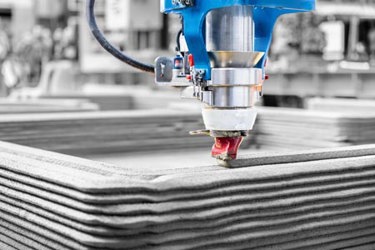3D Printing Concrete Reshapes Water Infrastructure, Layer By Layer
By Emily Newton

While three-dimensional printing has existed for some time, its impact on the water and wastewater industry has been almost negligible. Widespread adoption has dragged, potentially due to uncertainty. One recent development in 3D printing concrete is poised to change that.
A successful large-scale trial of 3D printing in water treatment recently concluded, demonstrating the viability of printing wastewater infrastructure. Moreover, new studies show underwater additive construction has become a practical, efficient alternative to existing methods. Where will industry professionals go from here?
3D-Printed Structures Signal The Start Of A Trend
In partnership with the Manchester Metropolitan University, ChangeMaker3D, and Scottish Water, the United Kingdom-based water supply company United Utilities plans to scale its 3D printing process across its daily operations after a successful two-year trial.
The decision comes after the Water Industry Printfrastructure program’s conclusion, where it achieved several industry firsts. One was the temporary 3D printing hub at a wastewater treatment plant opened in June 2024, where it produced industrial emissions directive containment walls and combined sewer overflow chambers.
Lisa Mansell, a chief engineer at United Utilities, said the experience was transformative and the company saw tangible results. It printed assets in hours rather than taking days or weeks to build them with traditional means. The method was financially and environmentally beneficial, reducing carbon emissions by 50%.
Since 3D printing in the water and wastewater sector is still in its infancy, a successful, real-world demonstration was vital for legitimizing it. This program and subsequent partnership are the signs industry professionals have been waiting for, noting the start of 3D printing in water treatment plants.
Professionals can use 3D printing concrete tools to build structures like septic tanks, vaults, box culverts, manholes, catch basins, and pipes on demand. They can use the same machines to produce manhole rings, supply lines, gratings, and filter elements because they can switch filaments at a moment’s notice.
The Significance Of 3D Printing Concrete Structures
What if utility providers could create custom, purpose-built concrete structures on demand? 3D printing enables on-site fabrication, even in complex environments. Take urban areas, for instance, where city officials must work around high-density infrastructure and reroute traffic.
This technology’s transformative properties extend to maintenance applications. Instead of replacing sections of a broken water line with heavy precast elements that take days or weeks to be delivered, professionals can leverage on-demand repair patches. By reducing lead times and shrinking the excavation area, they minimize disruption.
Stepping Away From Traditional Concrete Construction
Traditionally, pouring concrete has required a team of workers. Even monitoring it as it cures is time-consuming and labor-intensive when professionals use manual tests. Since commercial 3D printers generally only require one operator, labor requirements are minimal. Moreover, much of the process is automated.
Temperature monitoring is essential for evaluating structural integrity during printing and curing to ensure longevity. It is one of the few holdovers from the original pouring process. With sensor technology, professionals can measure and log the concrete’s internal and surface temperatures.
While thermocouples are slightly less accurate than other temperature sensors, their range is much broader. The base model can reach 2,552° F, while noble metal variations measure up to 5,432° F. Their readings are consistent and accurate.
Since professionals can optimize compressive strength this way, they can avoid using rebar to add tensile strength. When nothing gets in the way of the printing head and there is no need to pause between layers, they can work much faster.
How Professionals Benefit From 3D Printing Concrete
3D printing concrete water infrastructure is less carbon-intensive than pouring concrete on-site or using precast elements. It can also reduce transportation-related emissions by eliminating the need to operate transit mixers.
Aside from the environmental benefits, water and wastewater professionals should expect to accelerate their construction timelines. Some 3D printers can build a frame for a small house in just 48 hours, demonstrating the speed of additive production. They can complete more projects in less time without sacrificing material quality or structural integrity.
Even though these printers move faster, they do not increase material waste because they use a unique concrete mixture and an additive process. Since waste is a significant issue in the construction industry, this feature may help with brand perception and regulatory compliance.
Using 3D printing in water treatment provides advantages over conventional methods. It reduces construction costs by 78%, decreases water consumption by 20%, and lowers labor costs by 60%. Depending on the vendor, professionals may even save on materials. By lowering overhead and operational expenses, they gain the financial freedom to explore new solutions.
Reshaping The Water And Wastewater Utilities
Where will 3D printing concrete technology take the water and wastewater sector? While adoption may be limited to private companies with the funds to explore novel processes at the moment, public utility providers may soon adopt additive manufacturing techniques at scale. In this time, early adopters will develop numerous value-adding features and materials.
Although the technology for 3D printing in water treatment is still in its infancy, it shows promise. It is a cost-effective, efficient way to build underwater structures for marine engineering and utility projects. Robots with 3D printer arms can print concrete layer by layer underwater for pipeline repair, submarine tunnel construction, or offshore wind foundation construction.
Underwater machines use the water’s buoyancy to partially counterbalance the weight of the concrete, considerably improving its buildability while minimizing the use of support structures. The process is similar to gel suspension. While the environment weakens interlayer bonding, companies can overcome this obstacle with research and development.
As this technology progresses, the industry will simplify engineering, construction, and repairs. Cost-effective investments, shortened lead times, and improved print quality could lower entry barriers, shaking up the market and driving innovation.
The Future Of 3D-Printed Underwater Infrastructure
As this field matures, professionals will develop new robots, filaments, and coatings to further improve the construction process. Some are already exploring interfacing with internet-enabled technologies, which could allow them to deploy machines in dangerous, extreme, or remote environments without risk to personnel.
A 2020 report demonstrated a 3D-printable, self-sensing metakaolin geopolymer for the first time. It has a compressive strength of 24 megapascals and an adhesion strength of 0.6 megapascals. It has mechanical properties similar to ordinary Portland cement but with higher electrolytic conductivity. Professionals can use it as a coating on concrete substrate. They can also use printed sensors to enable on-demand, data-based repairs without human intervention.
With this invention, a diver or robot does not need to manually repair broken pipe sections or cracked chamber walls with concrete. Instead, the self-healing geopolymer can polymerize unreacted materials to heal cracks independently. This method addresses the limitations of existing maintenance methods.
Early adopters will benefit from faster builds, enhanced project quality, and reduced operational costs. Industry professionals should pay attention to this trend to determine their investment strategy. At the very least, they should prepare for its eventual impact.
Utilizing 3D Printing Technology In Water Treatment
When 3D printers first entered the mainstream, many considered them expensive hobby toys. However, as people moved from plastic filament to wood, carbon fiber, nylon, metal, and concrete, manufacturers discovered a world of possibilities. 3D printing concrete technology may be in its infancy, but studies and demonstrations prove its real-world viability.
As 3D printing in water treatment becomes more common, more people will understand the benefits of additive manufacturing, and demand for printed water and wastewater infrastructure will rise. Early adopters stand to benefit the most by establishing themselves as experts in the field before everyone else.
 Emily Newton is an industrial journalist. She regularly covers stories for the utilities and energy sectors. Emily is also editor in chief of Revolutionized (revolutionized.com).
Emily Newton is an industrial journalist. She regularly covers stories for the utilities and energy sectors. Emily is also editor in chief of Revolutionized (revolutionized.com).
